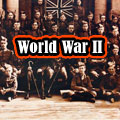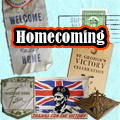Community in Transition: Red Deer in the Second World War
Michael Dawe
Reprinted with permission of the author and publisher of For King and Country: Alberta in the Second World War In another case, a young soldier on leave got too boisterous on a local bus and was ordered to take another bus. He took the suggestion literally and was caught driving the borrowed vehicle near Ponoka. He, too, was convicted, given a $100 fine and deprived of the rest of his leave.5
In another case, a young soldier on leave got too boisterous on a local bus and was ordered to take another bus. He took the suggestion literally and was caught driving the borrowed vehicle near Ponoka. He, too, was convicted, given a $100 fine and deprived of the rest of his leave.5
Early in 1941, the third group of trainees arrived at the militia training camp, and a new round of recruiting was conducted for the 2-78th Field Battery at the Armoury. In February, the Calgary Regiment [Tank] was mobilized and became the 14th Army Tank Battalion [Calgary Regiment]. Nearly 130 local men enlisted in this unit. In March a huge crowd saw them off in Calgary when they left for further training at Camp Borden in Ontario.
Meanwhile, the Federal Government announced that the training period for men called up under the National Service Act would be extended to four months from thirty days. Consequently, in March 1941, the military authorities announced that the militia-training centre would be changed into an eight-week advanced training camp for the Royal Canadian Army Service Corps. The new centre, which was named A-20, was to include 100 officers, 550 instructors, 500 active service men and 500 recruits in training. Work began on a number of new buildings, and large quantities of equipment and vehicles were transferred to Red Deer from other military installations.
While the new construction work got under way at the A-20 Camp, the work at the Penhold airport had progressed sufficiently that the military authorities were able to turn the base temporarily into No. 2A Manning Depot for the RCAP. As such, the facility was used for the initial training of fresh recruits prior to their being assigned to flying, wireless, or other training centres.
As the number of men and women on active service continued to mount, a decision was made by the federal authorities to have one coordinated national charity drive to raise funds for personal comforts and services. In March 1941, a joint appeal on behalf of the Salvation Army, YMCA, YWCA, Knights of Columbus, Royal Canadian Legion and IODE was launched with a nation¨wide objective of $5,500,000. Organizers in Red Deer and the surrounding area expected to raise between $3,000 and $3,500. To their surprise, more than $8,000 in contributions and pledges were received.
Immediately after the end of this War Services Drive, the Federal Government began its Victory Loan Campaign to sell bonds to finance the war effort. The Red Deer and District quota was set at $177 ,000. In order to get the appeal off to a strong and emotional start, the local officials organized the largest parade of military personnel and equipment in Red Deer's history. More than three thousand people turned out for the event. Within a month, the local organizers proudly reported that 132 per cent of the quota had been raised.
The great successes of the Victory Loan, War Services and other fund-raising campaigns reflected the tremendous increase in prosperity in the community since the start of the war. In contrast to the situation of only a few years before, jobs were now plentiful, wages were rising, business profits were increasing and local farmers were enjoying both abundant harvests and good prices for their produce. Instead of economic hardship and suffering, the war had engendered the best boom for Red Deer in thirty years.
The signs of the boom were everywhere. The Central Alberta Dairy Pool, which had been losing a great deal of money in the late 1930s, was now making a sizable profit. It consequently built a large addition onto its milk condensery. A new creamery was constructed on Ross Street by United Dairies, while Red Deer Bottling began building a new soft-drink works on Gaetz A venue South. Throughout the city, several new houses were built.
The wartime economy had some serious detriments. By the summer of 1941 there were growing shortages of several essential products. Sales of gasoline were cut off in Red Deer in the evenings and on Sundays. Inflation began to reappear. However, unlike the situation during the First World War, the Federal Government took strong corrective measures. In October 1941, the powers of the Wartime Prices and Trade Board were expanded. Stringent wage and price controls were imposed, and plans were set to implement a system of rationing.
The war also brought personal grief and suffering. In August 1940, the first man in Red Deer to have enlisted, Ben Long, became the first to be lost when he was killed in an accident in Manitoba. Three other men died of illness while on active service. In July 1941, a pilot in the RCAP, Matt Dunham, became the first local resident to be killed in action. The tragedy of war was starting to strike home.
During the summer of 1941 Red Deer was honoured by the Royal Canadian Navy when a new Bangor Class minesweeper was named after the city. While only two central Albertans ever served on the ship, a sense of camaraderie developed between the townspeople and the sailors. Letters and gifts were continually exchanged, and the local newspaper carefully followed the ship's activities and adventures.
In August 1941, construction work on the Penhold airport was finally completed. The RCAP discontinued the use of the facility as a manning depot and turned it over to the RAP for its new use as a Service Flying Training School. On 20 August 1941, the first contingent of 600 airmen arrived at the base. Unfortunately, actual flight training was slow in getting started; there was a critical shortage of qualified instructors and, initially, only twenty planes on hand.
Despite these handicaps, the pressures of the war made it imperative to use all resources to the utmost and to continue the recruitment and training of personnel. The military authorities began construction of another flying training school south of the Penhold air base near the Village of Bowden. Meanwhile, the Canadian Women's Army Corps recruited and stationed three companies in Red Deer for clerical, motor transport and commissariat duties.
With the hundreds of airmen at Penhold and the hundreds of soldiers and other personnel at the A-20 Camp, the problem of providing adequate recreation and entertainment facilities became more pressing. A private dance hall was built in North Red Deer to meet the need, while the YMCA built a large new recreation hut at the A-20 Camp. However, many people felt that there should be a public recreation centre in the city as well.
Notes
5. Red Deer Advocate, 1 January 1941.








